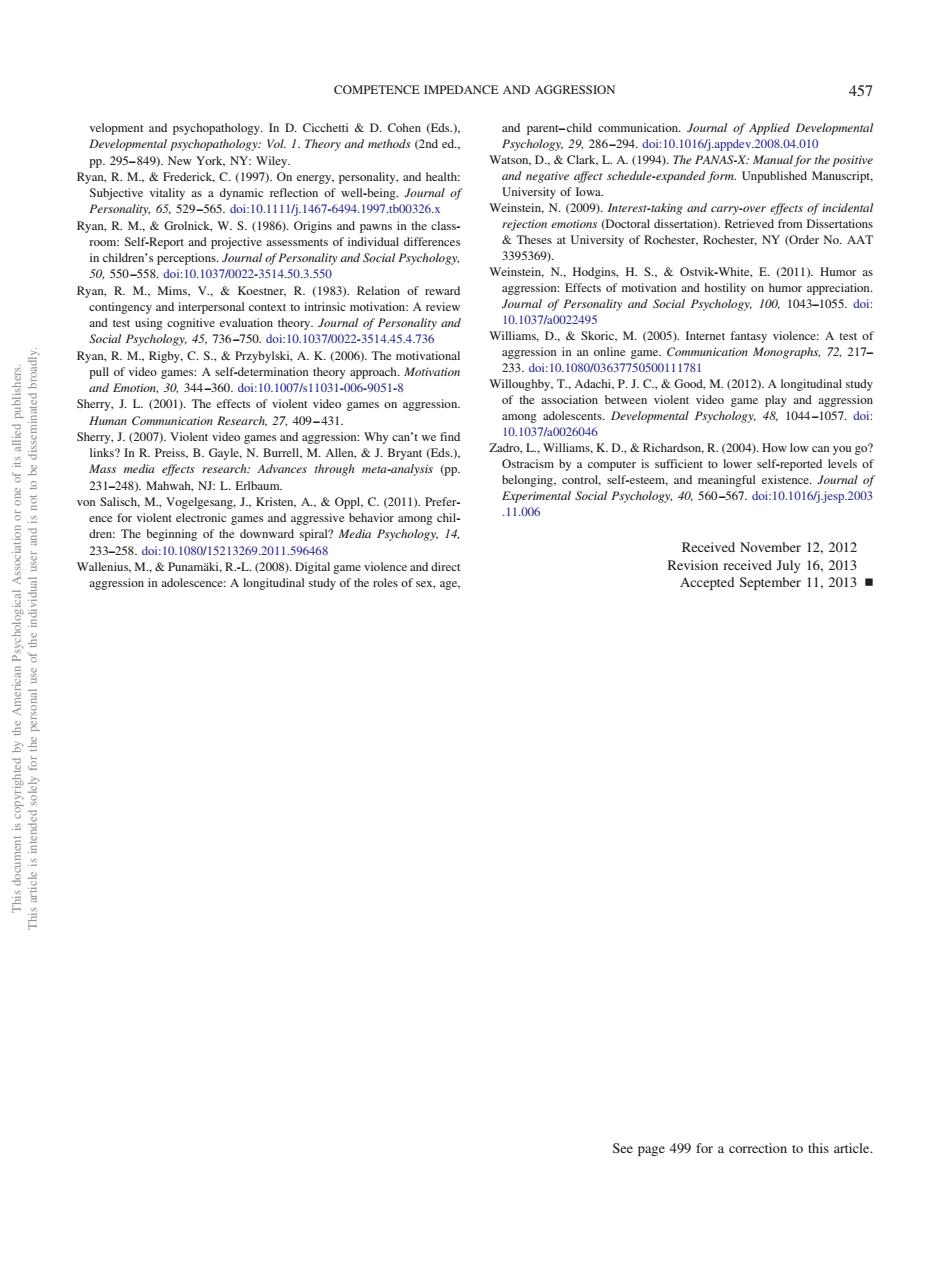正在加载图片...

COMPETENCE IMPEDANCE AND AGGRESSION 457 Watson,D.&Cla N.Hodgins.H.&Ostvik-White.E.(2011).Humor Ryan.R M.Mims.V&Koestner.R.(1983).Relation of reward R.M.Rigby.C.S&Przybylski.A.K.(2006).The moti M.All( Received November 12.2012 See page 499 for a correction to this articlevelopment and psychopathology. In D. Cicchetti & D. Cohen (Eds.), Developmental psychopathology: Vol. 1. Theory and methods (2nd ed., pp. 295– 849). New York, NY: Wiley. Ryan, R. M., & Frederick, C. (1997). On energy, personality, and health: Subjective vitality as a dynamic reflection of well-being. Journal of Personality, 65, 529 –565. doi:10.1111/j.1467-6494.1997.tb00326.x Ryan, R. M., & Grolnick, W. S. (1986). Origins and pawns in the classroom: Self-Report and projective assessments of individual differences in children’s perceptions. Journal of Personality and Social Psychology, 50, 550 –558. doi:10.1037/0022-3514.50.3.550 Ryan, R. M., Mims, V., & Koestner, R. (1983). Relation of reward contingency and interpersonal context to intrinsic motivation: A review and test using cognitive evaluation theory. Journal of Personality and Social Psychology, 45, 736 –750. doi:10.1037/0022-3514.45.4.736 Ryan, R. M., Rigby, C. S., & Przybylski, A. K. (2006). The motivational pull of video games: A self-determination theory approach. Motivation and Emotion, 30, 344 –360. doi:10.1007/s11031-006-9051-8 Sherry, J. L. (2001). The effects of violent video games on aggression. Human Communication Research, 27, 409 – 431. Sherry, J. (2007). Violent video games and aggression: Why can’t we find links? In R. Preiss, B. Gayle, N. Burrell, M. Allen, & J. Bryant (Eds.), Mass media effects research: Advances through meta-analysis (pp. 231–248). Mahwah, NJ: L. Erlbaum. von Salisch, M., Vogelgesang, J., Kristen, A., & Oppl, C. (2011). Preference for violent electronic games and aggressive behavior among children: The beginning of the downward spiral? Media Psychology, 14, 233–258. doi:10.1080/15213269.2011.596468 Wallenius, M., & Punamäki, R.-L. (2008). Digital game violence and direct aggression in adolescence: A longitudinal study of the roles of sex, age, and parent– child communication. Journal of Applied Developmental Psychology, 29, 286 –294. doi:10.1016/j.appdev.2008.04.010 Watson, D., & Clark, L. A. (1994). The PANAS-X: Manual for the positive and negative affect schedule-expanded form. Unpublished Manuscript, University of Iowa. Weinstein, N. (2009). Interest-taking and carry-over effects of incidental rejection emotions (Doctoral dissertation). Retrieved from Dissertations & Theses at University of Rochester, Rochester, NY (Order No. AAT 3395369). Weinstein, N., Hodgins, H. S., & Ostvik-White, E. (2011). Humor as aggression: Effects of motivation and hostility on humor appreciation. Journal of Personality and Social Psychology, 100, 1043–1055. doi: 10.1037/a0022495 Williams, D., & Skoric, M. (2005). Internet fantasy violence: A test of aggression in an online game. Communication Monographs, 72, 217– 233. doi:10.1080/03637750500111781 Willoughby, T., Adachi, P. J. C., & Good, M. (2012). A longitudinal study of the association between violent video game play and aggression among adolescents. Developmental Psychology, 48, 1044 –1057. doi: 10.1037/a0026046 Zadro, L., Williams, K. D., & Richardson, R. (2004). How low can you go? Ostracism by a computer is sufficient to lower self-reported levels of belonging, control, self-esteem, and meaningful existence. Journal of Experimental Social Psychology, 40, 560 –567. doi:10.1016/j.jesp.2003 .11.006 Received November 12, 2012 Revision received July 16, 2013 Accepted September 11, 2013 See page 499 for a correction to this article. This document is copyrighted by the American Psychological Association or one of its allied publishers. This article is intended solely for the personal use of the individual user and is not to be disseminated broadly. COMPETENCE IMPEDANCE AND AGGRESSION 457